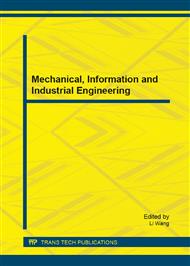p.116
p.120
p.127
p.131
p.136
p.142
p.146
p.150
p.154
Study of the Vibratory Stress Relief for Large-Scale Parallel Welded Steel Truss
Abstract:
Parallel welded steel truss component is widely used in construction, tower, bridges, aerospace and other fields. And the welding residual stress is distributed complicatedly in many areas and directions, which will definitely deform the welded steel truss or even crack it. So, it is necessary to do aging treatment to avoid such thing happened, as well as improve the accuracy and reliability. Vibratory stress relief (VSR) is a new kind of technology which may eliminate the residual stress in metal component with high efficiency, energy-saving, environment protection and low cost compared with thermal stress relief (TSR). But its technical effects vary with the vibration parameters. To the parallel steel truss structures, the excitation parameter of VSR is determined by welding residual stress distribution and the natural mode of vibration. The residual stress concentration areas can get enough vibration, if the parallel steel truss component vibrates with different kinds of natural mode of vibration, which will obtain good effect of eliminating stress. Firstly, the inherent vibration mode of parallel welded steel truss component is measured by the modal analysis technology. Secondly, multiple intrinsic modes are chosen according to principle of making all the welding residual stress concentration regions and directions get enough vibration and then main technical parameters are determined such as excitation frequency, excitation point and support point. In this paper, two examples are given out: the specimen 1is treated with the transverse bending vibration mode and torsion vibration mode respectively according to the above method. As for specimen 2, it is treated with 3 exciting frequencies which are located automatically by the vibration aging machine. The residual stresses of the two specimens are measured before and after their vibrations with blind holes method. Results show that after vibration aging, the welding residual stress peak figure of the Specimen 1 is reduced by an average of 48.65% and the mean value of that dropped by an average of 32.50%. Correspondingly, the residual stress peak value of the Specimen 2 shows a decline of 3.38%, its average fell by an average of 2.55%.
Info:
Periodical:
Pages:
136-141
Citation:
Online since:
March 2015
Authors:
Price:
Сopyright:
© 2015 Trans Tech Publications Ltd. All Rights Reserved
Share:
Citation:


